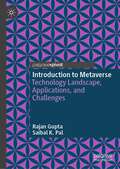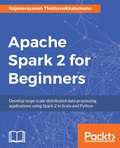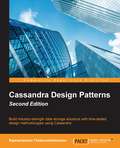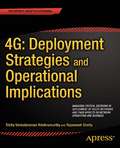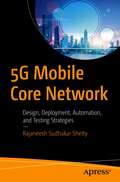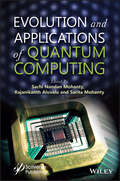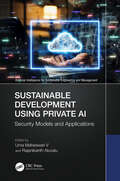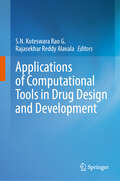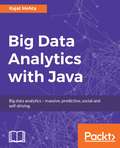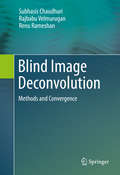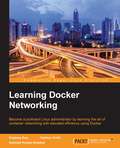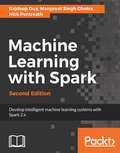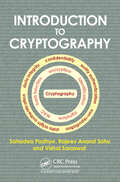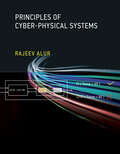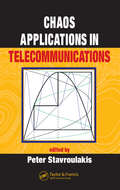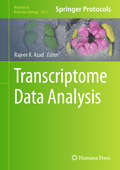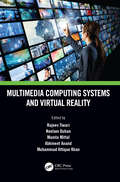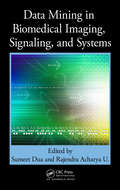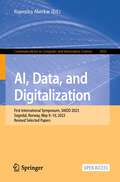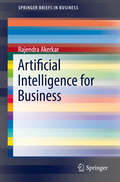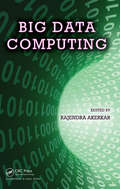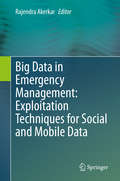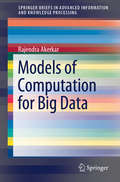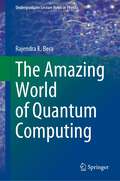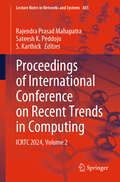- Table View
- List View
Introduction to Metaverse: Technology Landscape, Applications, and Challenges
by Rajan Gupta Saibal K. PalThis book discusses Metaverse Technology, which is one of the emerging technologies around the world, through its concepts, definitions, architectural layers, economic implications, and presents comparison points with other allied areas like Web 3.0, Digital Twin, Blockchain, Multiverse, Artificial Intelligence, Internet of Everything and Hyperautomation.The book also presents several use-cases and adoption areas of Metaverse technology, along with global outlook of top companies implementing this technology through major platforms and tools. The potential use of this technology for Public Sector is also explored in this book, apart from the suggested business framework for its adoption. Potential misuse and ethical concerns have also been summarised. This introductory book on Metaverse, written with a multidisciplinary approach, will provide readers with a clear understanding of what the Metaverse is, what technologies are involved in its creation, and its current as well as potential future applications, in a very simple manner.
Apache Spark 2 for Beginners
by Rajanarayanan ThottuvaikkatumanaDevelop large-scale distributed data processing applications using Spark 2 in Scala and Python About This Book * This book offers an easy introduction to the Spark framework published on the latest version of Apache Spark 2 * Perform efficient data processing, machine learning and graph processing using various Spark components * A practical guide aimed at beginners to get them up and running with Spark Who This Book Is For If you are an application developer, data scientist, or big data solutions architect who is interested in combining the data processing power of Spark from R, and consolidating data processing, stream processing, machine learning, and graph processing into one unified and highly interoperable framework with a uniform API using Scala or Python, this book is for you. What You Will Learn * Get to know the fundamentals of Spark 2 and the Spark programming model using Scala and Python * Know how to use Spark SQL and DataFrames using Scala and Python * Get an introduction to Spark programming using R * Perform Spark data processing, charting, and plotting using Python * Get acquainted with Spark stream processing using Scala and Python * Be introduced to machine learning using Spark MLlib * Get started with graph processing using the Spark GraphX * Bring together all that you've learned and develop a complete Spark application In Detail Spark is one of the most widely-used large-scale data processing engines and runs extremely fast. It is a framework that has tools that are equally useful for application developers as well as data scientists. This book starts with the fundamentals of Spark 2 and covers the core data processing framework and API, installation, and application development setup. Then the Spark programming model is introduced through real-world examples followed by Spark SQL programming with DataFrames. An introduction to SparkR is covered next. Later, we cover the charting and plotting features of Python in conjunction with Spark data processing. After that, we take a look at Spark's stream processing, machine learning, and graph processing libraries. The last chapter combines all the skills you learned from the preceding chapters to develop a real-world Spark application. By the end of this book, you will have all the knowledge you need to develop efficient large-scale applications using Apache Spark. Style and approach Learn about Spark's infrastructure with this practical tutorial. With the help of real-world use cases on the main features of Spark we offer an easy introduction to the framework.
Cassandra Design Patterns - Second Edition
by Rajanarayanan ThottuvaikkatumanaBuild real-world, industry-strength data storage solutions with time-tested design methodologies using CassandraAbout This BookExplore design patterns which co-exist with legacy data stores, migration from RDBMS, and caching technologies with CassandraLearn about design patterns and use Cassandra to provide consistency, availability, and partition tolerance guarantees for applicationsHandle temporal data for analytical purposesWho This Book Is ForThis book is intended for big data developers who are familiar with the basics of Cassandra and wish to understand and utilize Cassandra design patterns to develop real-world big data solutions. Prior knowledge of RDBMS solutions is assumed.What You Will LearnEnable Cassandra to co-exist with RDBMS and other legacy data storesExplore various design patterns to build effective and robust storage solutionsMigrate from RDBMS-based data stores and caching solutions to CassandraUnderstand the behaviour of Cassandra when trying to balance the needs of consistency, availability, and partition toleranceDeal with time stamps related to data effectivelySee how Cassandra can be used in analytical use casesApply the design patterns covered in this book in real-world use casesIn DetailThere are many NoSQL data stores used by big data applications. Cassandra is one of the most widely used NoSQL data stores that is frequently used by a huge number of heavy duty Internet-scale applications. Unlike the RDBMS world, the NoSQL landscape is very diverse and there is no one way to model data stores. This mandates the need to have good solutions to commonly seen data store design problems. Cassandra addresses such common problems simply.If you are new to Cassandra but well-versed in RDBMS modeling and design, then it is natural to model data in the same way in Cassandra, resulting in poorly performing applications and losing the real purpose of Cassandra. If you want to learn to make the most of Cassandra, this book is for you.This book starts with strategies to integrate Cassandra with other legacy data stores and progresses to the ways in which a migration from RDBMS to Cassandra can be accomplished. The journey continues with ideas to migrate data from cache solutions to Cassandra. With this, the stage is set and the book moves on to some of the most commonly seen problems in applications when dealing with consistency, availability, and partition tolerance guarantees.Cassandra is exceptionally good at dealing with temporal data and patterns such as the time-series pattern and log pattern, which are covered next. Many NoSQL data stores fail miserably when a huge amount of data is read for analytical purposes, but Cassandra is different in this regard. Keeping analytical needs in mind, you'll walk through different and interesting design patterns.No theoretical discussions are complete without a good set of use cases to which the knowledge gained can be applied, so the book concludes with a set of use cases you can apply the patterns you've learned.Style and approachThis book is written in very simple language and an engaging style complete with examples in every chapter and real-world use cases at the end of the book.
4G: Managing Critical Decisions in Deployment of 4G/LTE Networks and their Effects on Network Operations and Business
by Trichy Venkataraman Krishnamurthy Rajaneesh ShettyAs telecommunications operators and network engineers understand, specific operational requirements drive early network architectural and design decisions for 4G networks. But they also know that because technology, standards, usage practices, and regulatory regimes change on a continuous basis, so do best practices. 4G: Deployment Strategies and Operational Implications helps you stay up to date by providing the latest innovative and strategic thinking on 4G and LTE deployments. It evaluates specific design and deployment options in depth and offers roadmap evolution strategies for LTE network business development. Fortunately, as you''ll discover in this book, LTE is a robust and flexible standard for 4G communications. Operators developing 4G deployment strategies have many options, but they must consider the tradeoffs among them in order to maximize the return on investment for LTE networks. This book will show operators how to develop detailed but flexible deployment road maps incorporating business requirements while allowing the agility that expected and unexpected network evolution require. Such road maps help you avoid costly redeployment while leveraging profitable traffic. Telecommunications experts and authors Trichy Venkataraman Krishnamurthy and Rajaneesh Shetty examine various architectural options provided by the flexibility of LTE and their effect on the general current and future capability of the designed network. They examine specific features of the network, while covering specific architectural deployment strategies through example and then assessing their implications on both near- and long-term operations as well as potential evolutionary paths. Besides helping you understand and communicate network upgrade and architectural evolution road maps (with options), you will learn: How to plan for accessibility, retainability, integrity, availability, and mobility How to balance loads effectively How to manage the constraints arising from regulation and standardization How to manage the many disruptive factors affecting LTE networks 4G: Deployment Strategies and Operational Implications also outlines specific network strategies, which network features and deployment strategies support those strategies, and the trade-offs in business models depending on the strategies chosen. Best of all you will learn a process for proactive management of network road map evolution, ensuring that your network--and your skills--remain robust and relevant as the telecommunications landscape changes. What you''ll learn The relationships between network options, deployment strategies, network strategies, network road maps and operator business models. The process of developing and evolving strategies and roadmaps with a targeted operational model in mind. Ways to ensure maximum deployment flexibility to respond to changes in the operational model which might be forced by changing market conditions, usage models, or technological developments How to overcome 4G deployment challenges including equipment failure, spectrum interference, regulatory delays, and more How to ensure network resilience Who this book is for This book targets architectural, engineering and operational executives in the operator community as well as the network development contractors they employ to analyze, propose, design and in some cases operate their networks. Table of Contents 1. Network Planning 2. Self-Organizing Networks in LTE Deployment 3. Deployment Challenges in Evolving 4G 4. Network Roadmaps 5. Network Roadmap Evolution 6. A Process for Network Roadmap Evolution
5G Mobile Core Network: Design, Deployment, Automation, and Testing Strategies
by Rajaneesh Sudhakar ShettyGet up to speed on 5G and prepare for the roll out of the next generation of mobile technology. The book begins with an introduction to 5G and the advanced features of 5G networks, where you’ll see what makes it bigger, better, and faster. You will learn 5G NSA and SA packet core design along with some design challenges, taking a practical approach towards design and deployment. Next, you will understand the testing of the 5G packet core and how to automate it. The book concludes with some advanced service provider strategies, including architectural considerations for service providers to enhance their network and provide services to non-public 5G networks.5G Mobile Core Network is intended for those who wish to understand 5G, and also for those who work extensively in a service provider environment either as operators or as vendors performing activities such as network design, deployment, testing, and automation of the network. By the end of this book you will be able to understand the benefits in terms of CAPEX and OPEX while considering one design over another. Consulting engineers will be able to evaluate the design options in terms of 5G use cases, the scale of deployment, performance, efficiency, latency, and other key considerations. What You Will Learn Understand the life cycle of a deployment right from pre-deployment phase to post-deployment phaseSee use cases of 5G and the various options to design, implement, and deploy themExamine the deployment of 5G networks to large-scale service providersDiscover the MVNO/MVNE strategies that a service provider can implement in 5GWho This Book Is For Anyone who is curious about 5G and wants to learn more about the technology.
Evolution and Applications of Quantum Computing
by Sachi Nandan Mohanty Rajanikanth Aluvalu Sarita MohantyEVOLUTION and APPLICATIONS of QUANTUM COMPUTING The book is about the Quantum Model replacing traditional computing’s classical model and gives a state-of-the-art technical overview of the current efforts to develop quantum computing and applications for Industry 4.0. A holistic approach to the revolutionary world of quantum computing is presented in this book, which reveals valuable insights into this rapidly emerging technology. The book reflects the dependence of quantum computing on the physical phenomenon of superposition, entanglement, teleportation, and interference to simplify difficult mathematical problems which would have otherwise taken years to derive a definite solution for. An amalgamation of the information provided in the multiple chapters will elucidate the revolutionary and riveting research being carried out in the brand-new domain encompassing quantum computation, quantum information and quantum mechanics. Each chapter gives a concise introduction to the topic. The book comprises 18 chapters and describes the pioneering work on the interaction between artificial intelligence, machine learning, and quantum computing along with their applications and potential role in the world of big data. Subjects include: Combinational circuits called the quantum multiplexer with secured quantum gate (CSWAP); Detecting malicious emails and URLs by using quantum text mining algorithms to distinguish between phishing and benign sites; Quantum data traffic analysis for intrusion detection systems; Applications of quantum computation in banking, netnomy and vehicular ad-hoc networks, virtual reality in the education of autistic children, identifying bacterial diseases and accelerating drug discovery; The critical domain of traditional classical cryptography and quantum cryptography. Audience The book will be very useful for researchers in computer science, artificial intelligence and quantum physics as well as students who want to understand the history of quantum computing along with its applications and have a technical state-of-the-art overview.
Sustainable Development Using Private AI: Security Models and Applications (Artificial Intelligence for Sustainable Engineering and Management)
by Rajanikanth Aluvalu Uma Maheswari VThis book covers the fundamental concepts of private AI and its applications. It also covers fusion of Private AI with cutting-edge technologies like cloud computing, federated learning and computer vision.Security Models and Applications for Sustainable Development Using Private AI reviews various encryption algorithms used for providing security in private AI. It discusses the role of training machine learning and Deep learning technologies in private AI. The book provides case studies of using private AI in various application areas such as purchasing, education, entertainment, medical diagnosis, predictive care, conversational personal assistants, wellness apps, early disease detection, and recommendation systems. The authors provide additional knowledge to handling the customer’s data securely and efficiently. It also provides multi-model dataset storage approaches along with the traditional approaches like anonymization of data and differential privacy mechanisms.The target audience includes undergraduate and postgraduate students in Computer Science, Information technology, Electronics and Communication Engineering and related disciplines. This book is also a one stop reference point for professionals, security researchers, scholars, various government agencies and security practitioners, and experts working in the cybersecurity Industry specifically in the R & D division.
Applications of Computational Tools in Drug Design and Development
by S. N. Koteswara Rao G. Rajasekhar Reddy AlavalaThis book provides a comprehensive overview of the role of computers and computational tools at different stages of drug discovery and development. Designed to meet the needs of a beginner to advanced learner, the book provides the information on the tools, how they work, with the latest reports on applications in drug design, drug delivery and building network pharmacology models. Part I explores the pharmacological aspects, covering computational simulation of drug delivery at the molecular level, modeling for formulation design, and the revolutionary use of computational fluid dynamics in pharmaceutical processes. Specific applications such as pharmaceutical die filling processes, inhalation aerosol-based targeted drug delivery, and the development of inhalation compounds using in silico modeling tools are discussed. The use of computational tools in cheminformatics and their application in preformulation perspectives for drug delivery are also included. Part II expands the scope to include solubility prediction, absorption prediction, protein binding prediction, bio-permeability prediction, toxicity prediction, and metabolism prediction. It covers the identification of potential sites of metabolism in lead molecules and computer-assisted simulation studies to understand drug-polymer interactions. Recent advances in drug likeness screening using software and online tools are also reviewed. Part III focuses on specific therapeutic areas. <span class=
Big Data Analytics with Java
by Rajat MehtaLearn the basics of analytics on big data using Java, machine learning and other big data tools About This Book • Acquire real-world set of tools for building enterprise level data science applications • Surpasses the barrier of other languages in data science and learn create useful object-oriented codes • Extensive use of Java compliant big data tools like apache spark, Hadoop, etc. Who This Book Is For This book is for Java developers who are looking to perform data analysis in production environment. Those who wish to implement data analysis in their Big data applications will find this book helpful. What You Will Learn • Start from simple analytic tasks on big data • Get into more complex tasks with predictive analytics on big data using machine learning • Learn real time analytic tasks • Understand the concepts with examples and case studies • Prepare and refine data for analysis • Create charts in order to understand the data • See various real-world datasets In Detail This book covers case studies such as sentiment analysis on a tweet dataset, recommendations on a movielens dataset, customer segmentation on an ecommerce dataset, and graph analysis on actual flights dataset. This book is an end-to-end guide to implement analytics on big data with Java. Java is the de facto language for major big data environments, including Hadoop. This book will teach you how to perform analytics on big data with production-friendly Java. This book basically divided into two sections. The first part is an introduction that will help the readers get acquainted with big data environments, whereas the second part will contain a hardcore discussion on all the concepts in analytics on big data. It will take you from data analysis and data visualization to the core concepts and advantages of machine learning, real-life usage of regression and classification using Naive Bayes, a deep discussion on the concepts of clustering,and a review of simple neural networks on big data using deepLearning4j or plain Java Spark code. This book is a must-have book for Java developers who want to start learning big data analytics and want to use it in the real world. Style and approach The approach of book is to deliver practical learning modules in manageable content. Each chapter is a self-contained unit of a concept in big data analytics. Book will step by step builds the competency in the area of big data analytics. Examples using real world case studies to give ideas of real applications and how to use the techniques mentioned. The examples and case studies will be shown using both theory and code.
Blind Image Deconvolution: Methods and Convergence
by Subhasis Chaudhuri Rajbabu Velmurugan Renu RameshanBlind deconvolution is a classical image processing problem which has been investigated by a large number of researchers over the last four decades. The purpose of this monograph is not to propose yet another method for blind image restoration. Rather the basic issue of deconvolvability has been explored from a theoretical view point. Some authors claim very good results while quite a few claim that blind restoration does not work. The authors clearly detail when such methods are expected to work and when they will not. In order to avoid the assumptions needed for convergence analysis in the Fourier domain, the authors use a general method of convergence analysis used for alternate minimization based on three point and four point properties of the points in the image space. The authors prove that all points in the image space satisfy the three point property and also derive the conditions under which four point property is satisfied. This provides the conditions under which alternate minimization for blind deconvolution converges with a quadratic prior. Since the convergence properties depend on the chosen priors, one should design priors that avoid trivial solutions. Hence, a sparsity based solution is also provided for blind deconvolution, by using image priors having a cost that increases with the amount of blur, which is another way to prevent trivial solutions in joint estimation. This book will be a highly useful resource to the researchers and academicians in the specific area of blind deconvolution.
Learning Docker Networking
by Rajdeep Dua Santosh Kumar Konduri Vaibhav KohliBecome a proficient Linux administrator by learning the art of container networking with elevated efficiency using Docker About This Book * Set up, configure, and monitor a virtual network of containers using a bridge network and virtual switches * Master the skill of networking Docker Containers using frameworks such as Kubernetes, Docker Swarm, and Mesosphere * Acquire hands-on experience through practical examples of Docker networking spanning multiple containers, over multiple hosts, clubbed with various frameworks Who This Book Is For If you are a Linux administrator who wants to learn networking using Docker to ensure the efficient administration of core elements and applications, then this book is for you. Basic knowledge of LXC/Docker is assumed. What You Will Learn * Get to know the basics of networking and see how Docker networking works * Expose the strengths and weaknesses of the current Docker network implementation and third party landscape * Understand Docker networking spanning multiple containers over multiple hosts through practical examples * Observe the pitfalls of Docker networking and how to overcome them * Learn how Docker networking works for Docker Swarm and Kubernetes * Configure Networking using Docker's container network model (CNM) * Explore OpenvSwitch to connect contain In Detail Docker is a Linux container implementation that enables the creation of light weight portable development and production environments. These environments can be updated incrementally. Docker achieves this by leveraging containment principles like cgroups and Linux namespaces along with Overlay filesystem based portable images. Docker provides the networking primitives that allow administrators to specify how different containers network with each application and connect each of its components, then distribute them across a large number of servers and ensure coordination between them irrespective of the host or VM they are running in. This book will show you how to create, deploy, and manage a virtual network for connecting containers spanning single or multiple hosts. Style and approach This step-by-step guide covers the fundamentals relating to typical applications with a practical approach. There is a focus on providing the practical skills required to develop applications, with a summary of the key concepts where necessary.
Machine Learning with Spark - Second Edition
by Rajdeep DuaIf you have a basic knowledge of machine learning and want to implement various machine-learning concepts in the context of Spark ML, this book is for you. You should be well versed with the Scala and Python languages.
Introduction to Cryptography
by Vishal Saraswat Sahadeo Padhye Rajeev A. SahuElectronic communication and financial transactions have assumed massive proportions today. But they come with high risks. Achieving cyber security has become a top priority, and has become one of the most crucial areas of study and research in IT. This book introduces readers to perhaps the most effective tool in achieving a secure environment, i.e. cryptography. This book offers more solved examples than most books on the subject, it includes state of the art topics and discusses the scope of future research.
Principles of Cyber-Physical Systems
by Rajeev AlurA foundational text that offers a rigorous introduction to the principles of design, specification, modeling, and analysis of cyber-physical systems.A cyber-physical system consists of a collection of computing devices communicating with one another and interacting with the physical world via sensors and actuators in a feedback loop. Increasingly, such systems are everywhere, from smart buildings to medical devices to automobiles. This textbook offers a rigorous and comprehensive introduction to the principles of design, specification, modeling, and analysis of cyber-physical systems. The book draws on a diverse set of subdisciplines, including model-based design, concurrency theory, distributed algorithms, formal methods of specification and verification, control theory, real-time systems, and hybrid systems, explaining the core ideas from each that are relevant to system design and analysis.The book explains how formal models provide mathematical abstractions to manage the complexity of a system design. It covers both synchronous and asynchronous models for concurrent computation, continuous-time models for dynamical systems, and hybrid systems for integrating discrete and continuous evolution. The role of correctness requirements in the design of reliable systems is illustrated with a range of specification formalisms and the associated techniques for formal verification. The topics include safety and liveness requirements, temporal logic, model checking, deductive verification, stability analysis of linear systems, and real-time scheduling algorithms. Principles of modeling, specification, and analysis are illustrated by constructing solutions to representative design problems from distributed algorithms, network protocols, control design, and robotics.This book provides the rapidly expanding field of cyber-physical systems with a long-needed foundational text by an established authority. It is suitable for classroom use or as a reference for professionals.
Chaos Applications in Telecommunications
by Rajeev BansalThe concept of transmitting information from one chaotic system to another derives from the observation of the synchronization of two chaotic systems. Having developed two chaotic systems that can be synchronized, scientists can modulate on one phase signal the information to be transmitted, and subtract (demodulate) the information from the corres
Transcriptome Data Analysis (Methods in Molecular Biology #2812)
by Rajeev K. AzadThis detailed volume presents a comprehensive exploration of the advances in transcriptomics, with a focus on methods and pipelines for transcriptome data analysis. In addition to well-established RNA sequencing (RNA-Seq) data analysis protocols, the chapters also examine specialized pipelines, such as multi-omics data integration and analysis, gene interaction network construction, single-cell trajectory inference, detection of structural variants, application of machine learning, and more. As part of the highly successful Methods in Molecular Biology series, chapters include the kind of detailed implementation advice that leads to best results in the lab. Authoritative and practical, Transcriptome Data Analysis serves as an ideal resource for educators and researchers looking to understand new developments in the field, learn usage of the protocols for transcriptome data analysis, and implement the tools or pipelines to address relevant problemsof their interest. Chapter 4 is available open access under a Creative Commons Attribution 4.0 International License via link.springer.com.
Multimedia Computing Systems and Virtual Reality (Innovations in Multimedia, Virtual Reality and Augmentation)
by Rajeev TiwariMost events and activities in today's world are ordinarily captured using photos, videos and other multimedia content. Such content has some limitation of storing data and fetching them effectively. Three-dimensional continuous PC animation is the most proper media to simulate these occasions and activities. This book focuses on futuristic trends and innovations in multimedia systems using big data, IoT and cloud technologies. The authors present recent advancements in multimedia systems as they relate to various application areas such as healthcare services and agriculture-related industries. The authors also discuss human-machine interface design, graphics modelling, rendering/animation, image/graphics techniques/systems and visualization. They then go on to explore multimedia content adaptation for interoperable delivery. Finally, the book covers cultural heritage, philosophical/ethical/societal/international issues, standards-related virtual technology and multimedia uses. This book is intended for computer engineers and computer scientists developing applications for multimedia and virtual reality and professionals working in object design and visualization, transformation, modelling and animation of the real world. Features: Focuses on futuristic trends and innovations in multimedia systems using big data, IoT and cloud technologies Offers opportunity for state-of-the-art approaches, methodologies and systems, and innovative use of multimedia-based emerging technology services in different application areas Discusses human-machine interface design, graphics modelling, rendering/animation, image/graphics techniques/systems and visualization Covers cultural heritage, philosophical/ethical/societal/international issues, standards-related virtual technology and multimedia uses Explores multimedia content adaptation for interoperable delivery and recent advancements in multimedia systems in context to various application areas such as healthcare services and agriculture-related fields Rajeev Tiwari is a Senior Associate Professor in the School of Computer Science at the University of Petroleum and Energy Studies, Dehradun, India. Neelam Duhan is an Associate Professor in the Department of Computer Engineering at J. C. Bose University of Science and Technology, YMCA, Faridabad, India. Mamta Mittal has 18 years of teaching experience, and her research areas include data mining, big data, machine learning, soft computing and data structure. Abhineet Anand is a Professor in the Computer Science and Engineering Department at Chitkara University, Punjab, India. Muhammad Attique Khan is a lecturer of the Computer Science Department at HITEC University, Taxila, Pakistan.
Data Mining in Biomedical Imaging, Signaling, and Systems
by Rajendra Acharya U Sumeet DuaData mining can help pinpoint hidden information in medical data and accurately differentiate pathological from normal data. It can help to extract hidden features from patient groups and disease states and can aid in automated decision making. Data Mining in Biomedical Imaging, Signaling, and Systems provides an in-depth examination of the biomedi
AI, Data, and Digitalization: First International Symposium, SAIDD 2023, Sogndal, Norway, May 9–10, 2023, Revised Selected Papers (Communications in Computer and Information Science #1810)
by Rajendra AkerkarThis open access book constitutes the revised selected papers of the First International Symposium on AI, Data and Digitalization, SAIDD 2023, held in Sogndal, Norway, during May 9–10, 2023.The 13 full papers included in this volume were carefully reviewed and selected from 42 submissions. The papers deal with the impact of data and AI on the digital revolution and their contribution to solving societal challenges.
Artificial Intelligence for Business (SpringerBriefs in Business)
by Rajendra AkerkarThis book offers a practical guide to artificial intelligence (AI) techniques that are used in business. The book does not focus on AI models and algorithms, but instead provides an overview of the most popular and frequently used models in business. This allows the book to easily explain AI paradigms and concepts for business students and executives. Artificial Intelligence for Business is divided into six chapters. Chapter 1 begins with a brief introduction to AI and describes its relationship with machine learning, data science and big data analytics. Chapter 2 presents core machine learning workflow and the most effective machine learning techniques. Chapter 3 deals with deep learning, a popular technique for developing AI applications. Chapter 4 introduces recommendation engines for business and covers how to use them to be more competitive. Chapter 5 features natural language processing (NLP) for sentiment analysis focused on emotions. With the help of sentiment analysis, businesses can understand their customers better to improve their experience, which will help the businesses change their market position. Chapter 6 states potential business prospects of AI and the benefits that companies can realize by implementing AI in their processes.
Big Data Computing
by Rajendra AkerkarDue to market forces and technological evolution, Big Data computing is developing at an increasing rate. A wide variety of novel approaches and tools have emerged to tackle the challenges of Big Data, creating both more opportunities and more challenges for students and professionals in the field of data computation and analysis. Presenting a mix
Big Data in Emergency Management: Exploitation Techniques for Social and Mobile Data
by Rajendra AkerkarThis contributed volume discusses essential topics and the fundamentals for Big Data Emergency Management and primarily focusses on the application of Big Data for Emergency Management. It walks the reader through the state of the art, in different facets of the big disaster data field. This includes many elements that are important for these technologies to have real-world impact. This book brings together different computational techniques from: machine learning, communication network analysis, natural language processing, knowledge graphs, data mining, and information visualization, aiming at methods that are typically used for processing big emergency data. This book also provides authoritative insights and highlights valuable lessons by distinguished authors, who are leaders in this field.Emergencies are severe, large-scale, non-routine events that disrupt the normal functioning of a community or a society, causing widespread and overwhelming losses and impacts. Emergency Management is the process of planning and taking actions to minimize the social and physical impact of emergencies and reduces the community’s vulnerability to the consequences of emergencies. Information exchange before, during and after the disaster periods can greatly reduce the losses caused by the emergency. This allows people to make better use of the available resources, such as relief materials and medical supplies. It also provides a channel through which reports on casualties and losses in each affected area, can be delivered expeditiously. Big Data-Driven Emergency Management refers to applying advanced data collection and analysis technologies to achieve more effective and responsive decision-making during emergencies.Researchers, engineers and computer scientists working in Big Data Emergency Management, who need to deal with large and complex sets of data will want to purchase this book. Advanced-level students interested in data-driven emergency/crisis/disaster management will also want to purchase this book as a study guide.
Models of Computation for Big Data (Advanced Information and Knowledge Processing)
by Rajendra AkerkarThe big data tsunami changes the perspective of industrial and academic research in how they address both foundational questions and practical applications. This calls for a paradigm shift in algorithms and the underlying mathematical techniques. There is a need to understand foundational strengths and address the state of the art challenges in big data that could lead to practical impact. The main goal of this book is to introduce algorithmic techniques for dealing with big data sets. Traditional algorithms work successfully when the input data fits well within memory. In many recent application situations, however, the size of the input data is too large to fit within memory. Models of Computation for Big Data, covers mathematical models for developing such algorithms, which has its roots in the study of big data that occur often in various applications. Most techniques discussed come from research in the last decade. The book will be structured as a sequence of algorithmic ideas, theoretical underpinning, and practical use of that algorithmic idea. Intended for both graduate students and advanced undergraduate students, there are no formal prerequisites, but the reader should be familiar with the fundamentals of algorithm design and analysis, discrete mathematics, probability and have general mathematical maturity.
The Amazing World of Quantum Computing (Undergraduate Lecture Notes in Physics)
by Rajendra K. BeraThis book discusses the application of quantum mechanics to computing. It explains the fundamental concepts of quantum mechanics and then goes on to discuss various elements of mathematics required for quantum computing. Quantum cryptography, waves and Fourier analysis, measuring quantum systems, comparison to classical mechanics, quantum gates, and important algorithms in quantum computing are among the topics covered.The book offers a valuable resource for graduate and senior undergraduate students in STEM (science, technology, engineering, and mathematics) fields with an interest in designing quantum algorithms. Readers are expected to have a firm grasp of linear algebra and some familiarity with Fourier analysis.
Proceedings of International Conference on Recent Trends in Computing: ICRTC 2024, Volume 2 (Lecture Notes in Networks and Systems #885)
by Sateesh K. Peddoju Rajendra Prasad Mahapatra S. KarthickThis book is a collection of high-quality peer-reviewed research papers presented at the International Conference on Recent Trends in Computing (ICRTC 2024), organized by SRM Institute of Science and Technology, Ghaziabad, held in Delhi, India, from July 5–6, 2024. The book is divided into two volumes and discusses a wide variety of industrial, engineering, and scientific applications of emerging techniques. It presents original works from researchers in academia and industry in the fields of networking, security, big data, and the Internet of Things.
